分类号
学校代码 1 0 4 8 7
学号 M201676105
密级
硕 士 学 位 论 文
基于 Spring Boot 的校园轻博客系统
的设计与实现
学位申请人:邓 笑
学 科 专 业:软件工程
指 导 教 师:卢 力 副教授
答 辩 日 期:2018.12.19
�
A Thesis Submitted in Partial Fulfillment of the Requirements for
the Degree for the Master of Engineering
Design and Implementation of a Campus Light
Blog System Based on Spring Boot
Candidate
: Deng Xiao
Major
: Software Engineering
Supervisor
:Assoc. Prof. Lu Li
Huazhong University of Science & Technology
Wuhan 430074, P.R.China
December, 2018
�
�
华 中 科 技 大 学 硕 士 学 位 论 文
摘 要
随着互联网的普及,网络几乎成为了人们搜集信息和交流沟通最方便最快捷的
通道,网络同时也给了人们充分表达自我的舞台。在这样的全民交流的时代背景下,
在校园里开辟一块属于全校师生的交流天地,为老师之间、学生之间、以及师生之
间的交流建立一个简单干净的网络平台,是具有重要意义的。基于此目的,同时轻
博客具有多样表达以及简单社交等特点,Spring Boot又是轻量级框架,具有方便开发
和维护等特点,所以设计并实现了基于Spring Boot的校园轻博客系统。
根据软件生存周期的流程,首先对系统进行需求分析,分别对系统的功能、性
能以及安全需求进行分析,然后对系统进行总体设计,将整个系统分为系统管理模
块、博文管理模块、标签管理模块、互动管理模块以及用户信息管理模块,并对具
体的模块进行详细设计,接着借助开发工具实现系统的博文浏览、博文搜索、博文
编辑,以及用户管理和博客管理等核心功能,最后借助软件测试方法对系统的功能、
性能以及安全性进行测试。
总的来说,校园轻博客系统的功能基本实现,同时性能和安全性也得到了相应
的保障:系统借助 Spring Boot+MyBatis 开发框架使得代码结构低耦合,系统易于开
发和维护;前端框架以及多种插件使得系统支持多种发布形式,界面简洁、操作简
单;Apache Shiro 安全框架和过滤器等多种技术保障系统安全。
关键词:轻博客
Spring Boot 框架
软件测试
安全框架
I
�
华 中 科 技 大 学 硕 士 学 位 论 文
Abstract
is important
With the popularity of the Internet, the Internet has become the most convenient and
fastest channel for people to collect information and communicate. The network also gives
people a stage to fully express themselves. In the context of such a nationwide exchange,
it
to open up a network of exchanges between teachers and students
the school, and to establish a simple and clean network platform for
throughout
communication between teachers,
students, and between teachers and students.
meaningful. For this purpose, while the light blog has a variety of expressions and simple
social features, Spring Boot is a lightweight framework, with convenient development and
maintenance features, so designed and implemented a Spring Boot-based campus light
blog system.
According to the software life cycle process,
the system first analyzes the
requirements of the system, analyzes the functions, performance and security requirements
of the system,
then designs the system, and divides the whole system into system
management module, blog management module and label management module.
,
interactive management module and user information management module, and detailed
design of specific modules, and then use the development tools to achieve the system's
blog browsing, blog post search, blog post editing, as well as user management and blog
management and other core functions, and finally by means of software testing methods
Test the functionality, performance, and security of your system.
In general, the functions of the campus light blog system are basically realized, and
the performance and security are also guaranteed accordingly: the system uses the Spring
Boot+MyBatis development framework to make the code structure low-coupling, the
system is easy to develop and maintain; the front-end framework and many The plug-in
enables the system to support multiple publishing formats, with a simple interface and
simple operation; Apache Shiro security framework and filters and other technologies to
ensure system security.
Key words: Light blog
Spring Boot framework
Software test
Security framework
II
�
华 中 科 技 大 学 硕 士 学 位 论 文
目 录
摘 要................................................................................................................ I
Abstract............................................................................................................ II
1 绪论
1.1 研究背景与意义....................................................................................(1)
1.2 国内外研究概况....................................................................................(2)
1.3 主要研究内容........................................................................................(3)
2 关键技术分析
2.1 Web MVC 模式..................................................................................... (5)
2.2 Spring Boot 框架................................................................................... (7)
2.3 MyBatis 框架.........................................................................................(9)
2.4 Apache Shiro 框架...............................................................................(11)
2.5 本章小结..............................................................................................(12)
3 系统分析与设计
3.1 系统需求分析......................................................................................(13)
3.2 系统总体设计......................................................................................(19)
3.3 系统功能模块设计..............................................................................(21)
3.4 系统数据库设计..................................................................................(31)
3.5 系统安全设计......................................................................................(37)
3.6 本章小结..............................................................................................(39)
4 系统实现与测试
4.1 系统开发环境......................................................................................(40)
4.2 系统功能模块实现..............................................................................(40)
III
�
华 中 科 技 大 学 硕 士 学 位 论 文
4.3 系统安全实现......................................................................................(54)
4.4 系统测试..............................................................................................(58)
4.5 本章小结..............................................................................................(63)
5 总结与展望
5.1 全文总结..............................................................................................(64)
5.2 展望......................................................................................................(65)
致 谢...........................................................................................................(66)
参考文献.......................................................................................................(67)
IV
�
华 中 科 技 大 学 硕 士 学 位 论 文
1 绪论
1.1 研究背景与意义
高校中的学生正处于寻找自我的阶段,刚成年或已成年,思想或许正处于萌芽
期,急于向世界宣告自己独立而特别的存在;或许少年老成,已学会表达自我多时。
同时,如今的网络时代也已向人们提供了大量的方式去认识世界、感知世界,如微
博,刷一刷即可了解此刻最新最劲爆的消息;微信,摇一摇即可结识身边或近或远
的人们;抖音,拍一拍即可记录或感动或搞笑的瞬间。轻博客作为一种介于微博和
博客之间的一种网络社交模式,它既继承了博客的表达基因,注重内容为主以及兴
趣驱动,同时保留了微博的传播基因,保留用户之间的互动,包括评论、喜欢、转
发等特点,使其具有线上“俱乐部”之称,以兴趣主导,以精致表达吸引围观,进而
形成互相分享、互相学习、互相探讨的良好社交氛围。
高校的学生们所能获取信息以及表达自我的网络媒体通道有贴吧、BBS、微博
公众号、微信公众号、人人网、QQ群及其公众号等方式,但无一种是师生们能全体
参与并且自由表达的方式。贴吧多为学生“地下组织”,虽也有管理员管理,但信息
鱼龙混杂,有效信息很难获取;BBS虽含有大量信息,但因其编辑复杂以及其界面
较为陈旧,很难吸引学生长久驻留;各类公众号多用于发布通知,且具有一定的工
作性质,这使得公众号维护者必须定期更新,同时务必保证信息准确。
校园轻博客系统的意义主要体现在以下几个方面:
(1)轻博客帮助学生养成文字表达的行为习惯。轻博客作为比博客相对轻松,
比微博相对严肃的方式,用精致内容表达着对世界的认知,表达着对自我的探寻,
表达着对梦想的追寻,表达着对现实的抵抗。文字图片的排版以及内容编排需要静
下来去思考、去沉淀,这其实给了高校的学生们一种去浮躁的表达方式,也是帮助
学生们养成文字表达的行为习惯。
(2)校园环境使得交流更加安全可靠。通过表达认识一批志同道合的伙伴们,
这些小伙伴可能是比你小一两届的学弟学妹们,可能是比你高几届的学长学姐们,
1
�
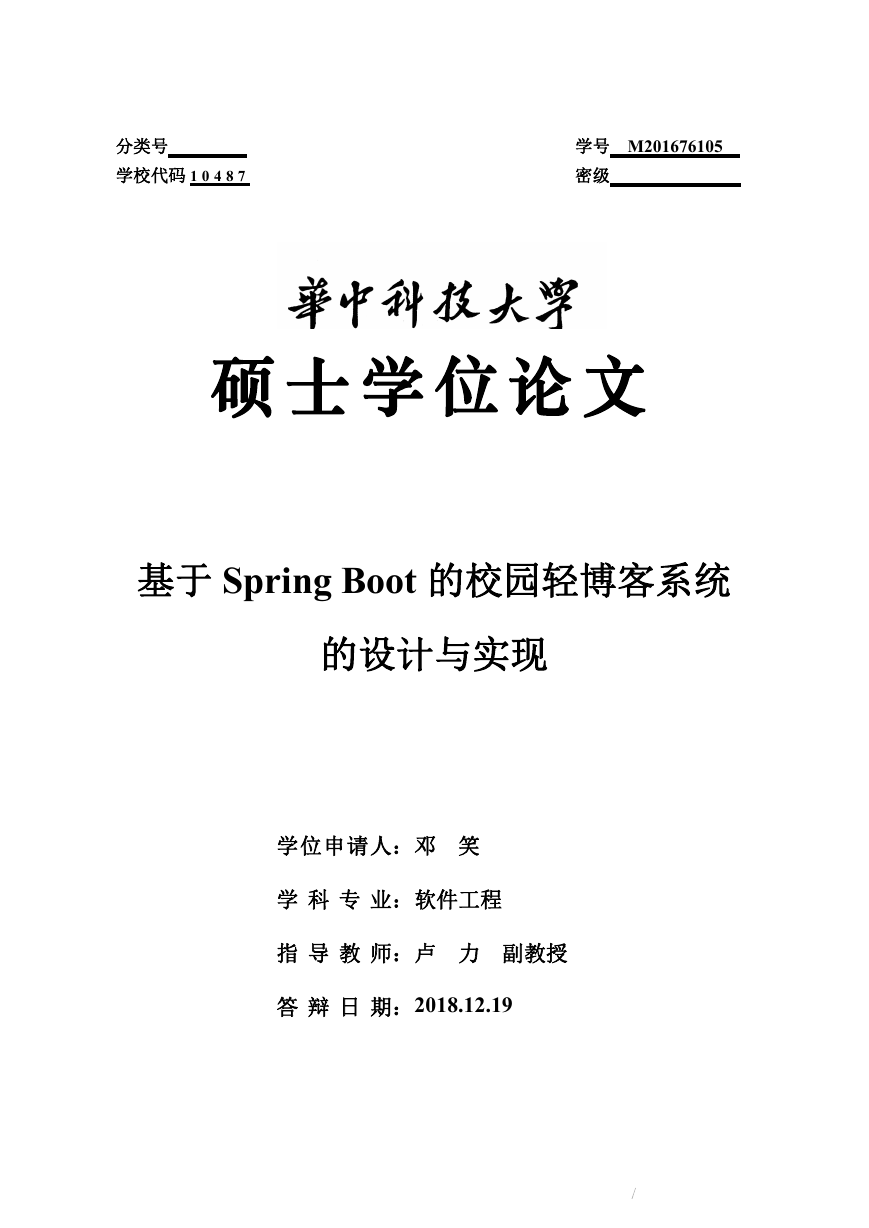
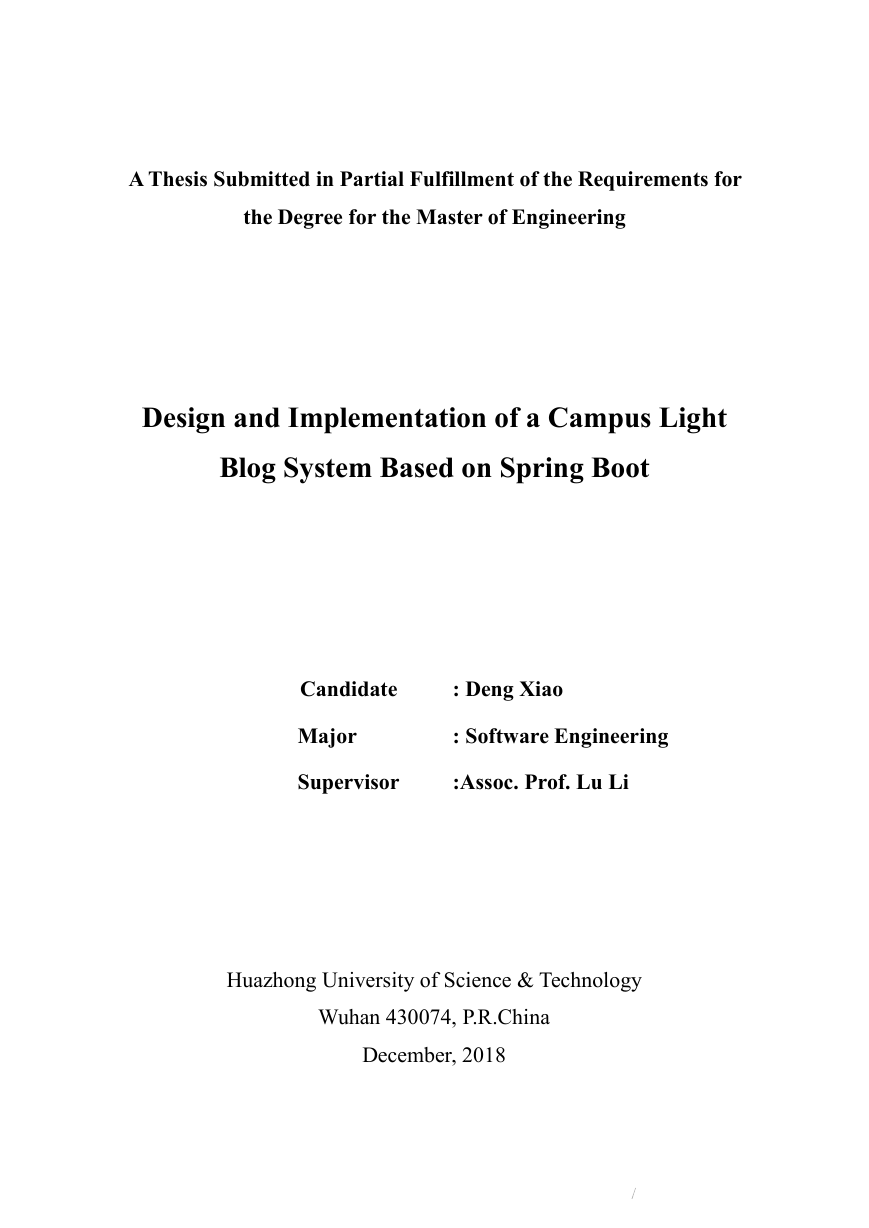

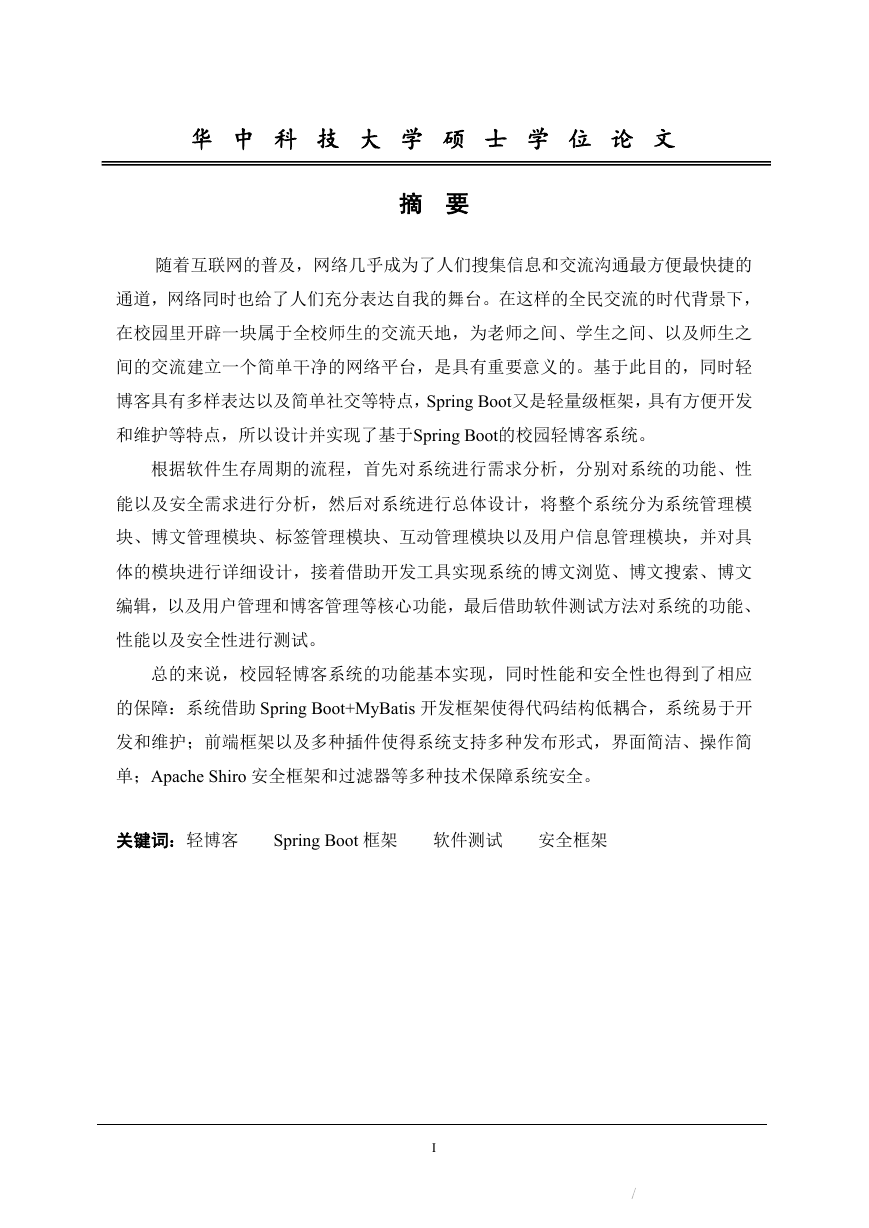
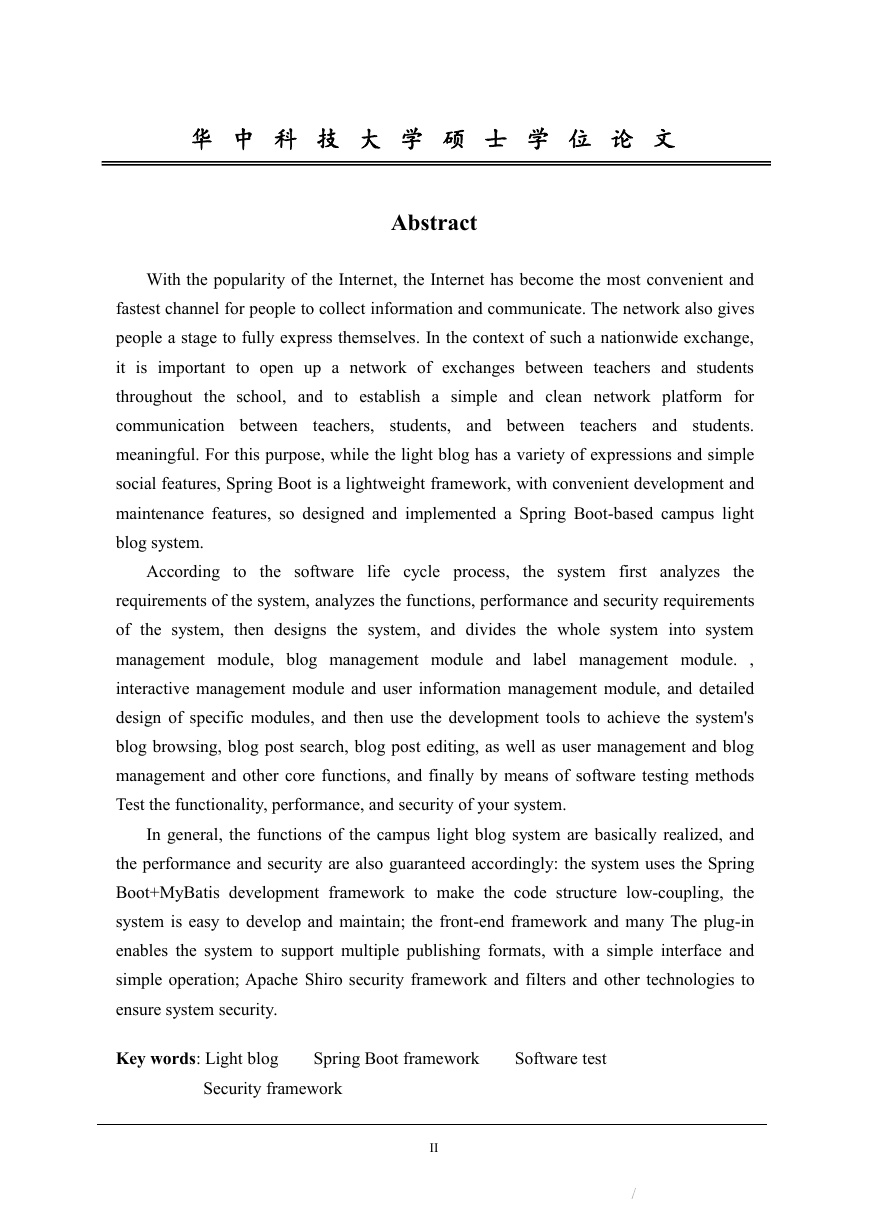
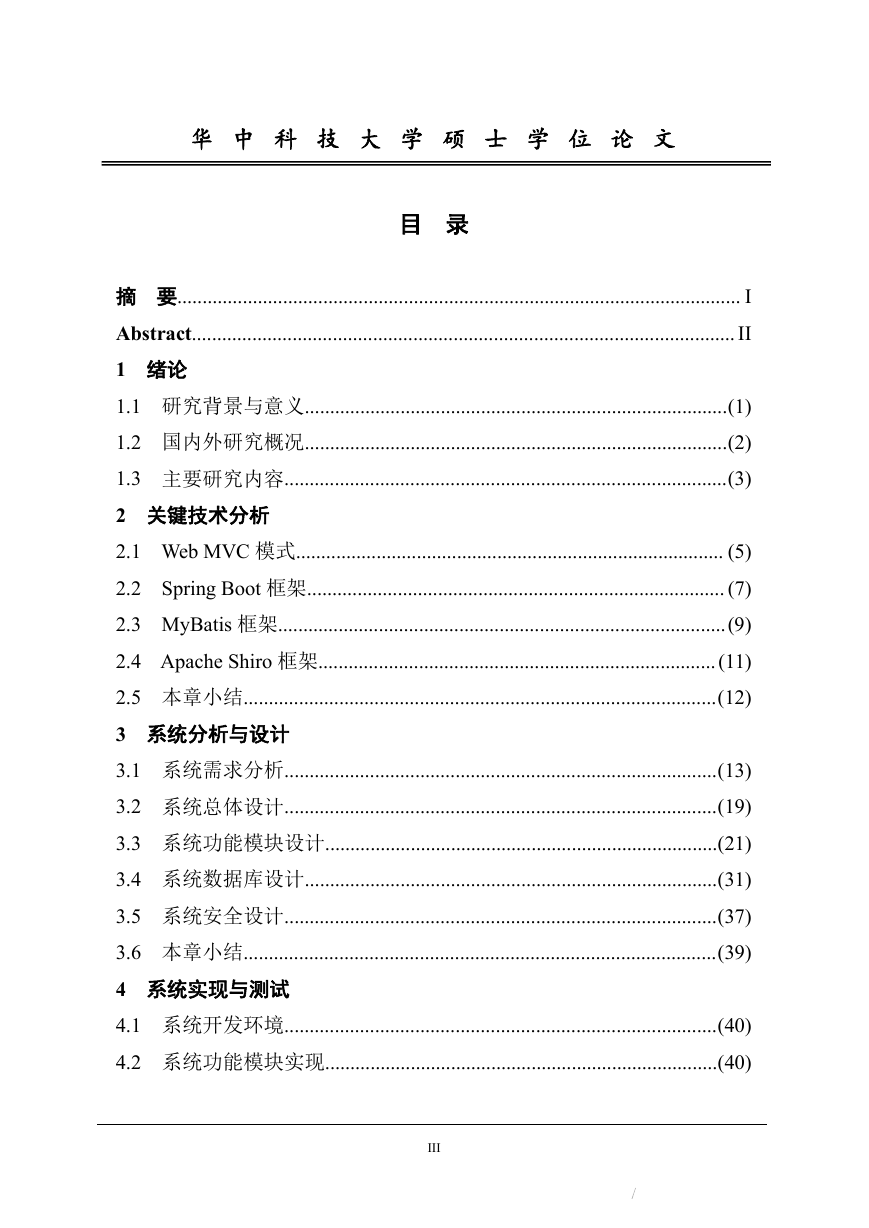
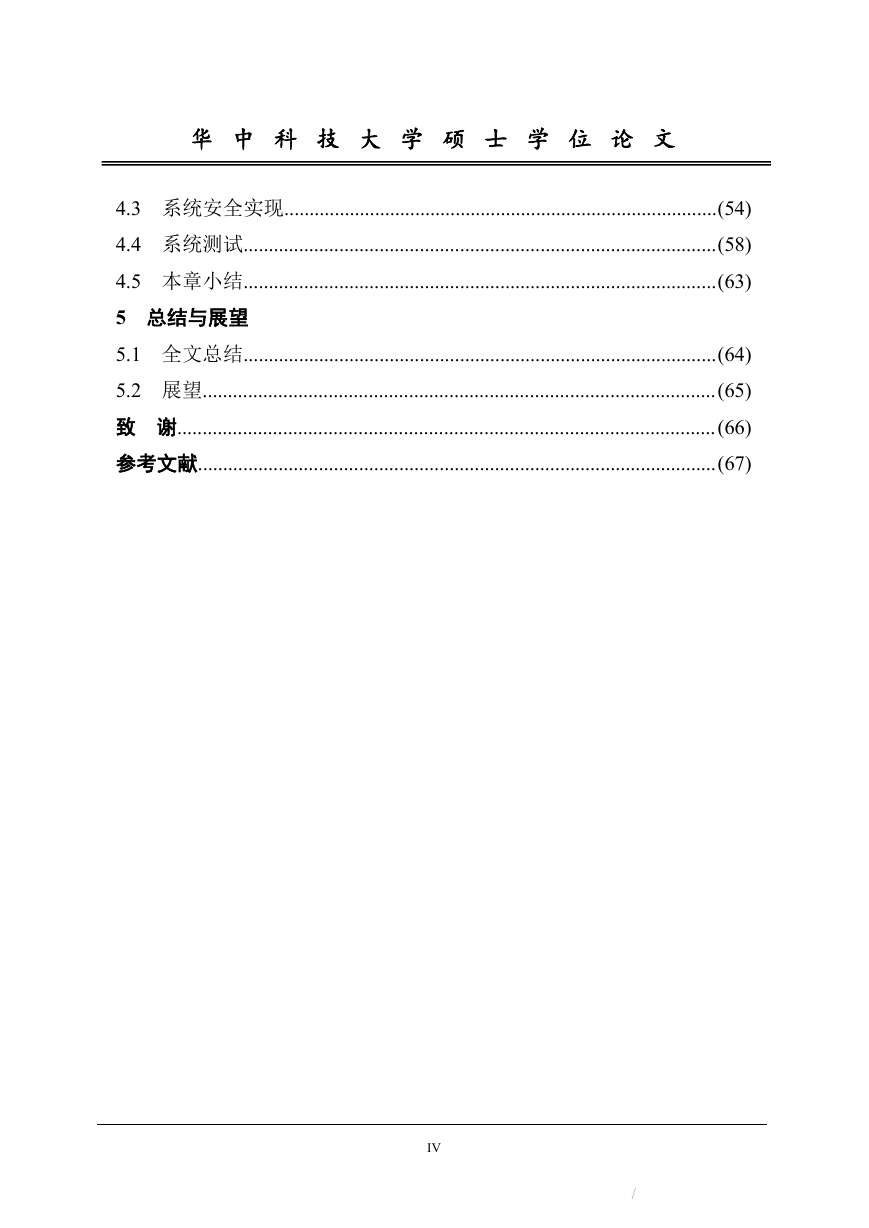









 2023年江西萍乡中考道德与法治真题及答案.doc
2023年江西萍乡中考道德与法治真题及答案.doc 2012年重庆南川中考生物真题及答案.doc
2012年重庆南川中考生物真题及答案.doc 2013年江西师范大学地理学综合及文艺理论基础考研真题.doc
2013年江西师范大学地理学综合及文艺理论基础考研真题.doc 2020年四川甘孜小升初语文真题及答案I卷.doc
2020年四川甘孜小升初语文真题及答案I卷.doc 2020年注册岩土工程师专业基础考试真题及答案.doc
2020年注册岩土工程师专业基础考试真题及答案.doc 2023-2024学年福建省厦门市九年级上学期数学月考试题及答案.doc
2023-2024学年福建省厦门市九年级上学期数学月考试题及答案.doc 2021-2022学年辽宁省沈阳市大东区九年级上学期语文期末试题及答案.doc
2021-2022学年辽宁省沈阳市大东区九年级上学期语文期末试题及答案.doc 2022-2023学年北京东城区初三第一学期物理期末试卷及答案.doc
2022-2023学年北京东城区初三第一学期物理期末试卷及答案.doc 2018上半年江西教师资格初中地理学科知识与教学能力真题及答案.doc
2018上半年江西教师资格初中地理学科知识与教学能力真题及答案.doc 2012年河北国家公务员申论考试真题及答案-省级.doc
2012年河北国家公务员申论考试真题及答案-省级.doc 2020-2021学年江苏省扬州市江都区邵樊片九年级上学期数学第一次质量检测试题及答案.doc
2020-2021学年江苏省扬州市江都区邵樊片九年级上学期数学第一次质量检测试题及答案.doc 2022下半年黑龙江教师资格证中学综合素质真题及答案.doc
2022下半年黑龙江教师资格证中学综合素质真题及答案.doc